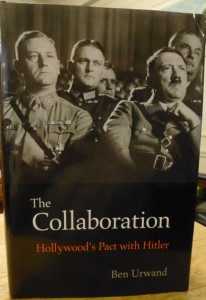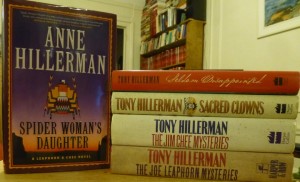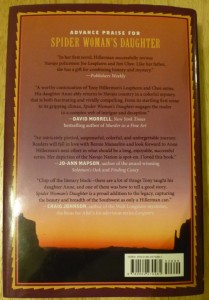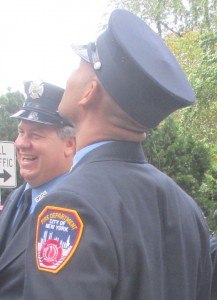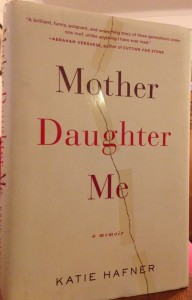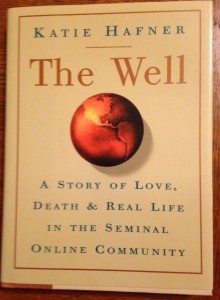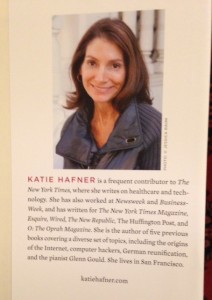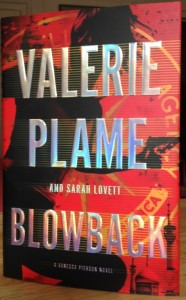Jayne Anne Phillips Launches “Quiet Dell” at the Strand Bookstore
Eager to hear @JayneAnneOnly tonite on her new book QUIET DELL at the Strand. My blog on the novel-http://t.co/sOmlaN2gVd @ScribnerBooks
— Philip Turner (@philipsturner) October 15, 2013
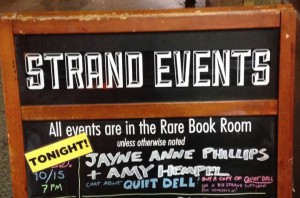 Among the best books that I discovered during Book Expo America (BEA) last June, was Quiet Dell by Jayne Anne Phillips. In August I had made this mesmerizing novel–set in 1930s West Virginia, drawn from the annals of a notorious true crime–one of my #FridayReads and have written about it a few times since, including in a post about what I’ve dubbed “documentary fiction.” Early newspaper reviews have been great, including praise by the Tampa Bay Times Book Editor Colette Bancroft (“Sometimes eerie and dreamlike, others grippingly tense, yet warmly human, always written with beauty and emotional power, Quiet Dell is a virtuoso performance by a highly original writer.”); Amy Driscoll in the Miami Herald (“A smart combination of true crime, history and fiction tied together with Phillips’ seamlessly elegant writing….Phillips writes with a tone that is sometimes impressionistic, sometimes hard-edged. It’s a linguistic balancing act that results in an emotional chiaroscuro.”); and Celia McGee in the Chicago Tribune (“If the factual underpinnings of this latest novel are unusual for Phillips, her ability to transform them into a fictionalized narrative place her at the top of her form. Phillips has…create[d] a story both splendid and irreparably sad.”).
Among the best books that I discovered during Book Expo America (BEA) last June, was Quiet Dell by Jayne Anne Phillips. In August I had made this mesmerizing novel–set in 1930s West Virginia, drawn from the annals of a notorious true crime–one of my #FridayReads and have written about it a few times since, including in a post about what I’ve dubbed “documentary fiction.” Early newspaper reviews have been great, including praise by the Tampa Bay Times Book Editor Colette Bancroft (“Sometimes eerie and dreamlike, others grippingly tense, yet warmly human, always written with beauty and emotional power, Quiet Dell is a virtuoso performance by a highly original writer.”); Amy Driscoll in the Miami Herald (“A smart combination of true crime, history and fiction tied together with Phillips’ seamlessly elegant writing….Phillips writes with a tone that is sometimes impressionistic, sometimes hard-edged. It’s a linguistic balancing act that results in an emotional chiaroscuro.”); and Celia McGee in the Chicago Tribune (“If the factual underpinnings of this latest novel are unusual for Phillips, her ability to transform them into a fictionalized narrative place her at the top of her form. Phillips has…create[d] a story both splendid and irreparably sad.”).
The book was officially published yesterday, and I was excited to attend Phillips’ first reading and signing for it last night. The event drew a big crowd to the Rare Book Room at the Strand Bookstore. Phillips read three sections from the novel, introducing nine-year old Annabel Eicher, who has a lingering presence in the narrative, even after she and her family are taken off by their killer, under the guise of her widowed mother’s suitor; a dog with the Victorian name, Duty, a kind of avenger on behalf of the Eicher family that had adopted the loyal Boston Terrier (the AP review dubs him “one of fiction’s best dogs); and journalist Emily Thornhill, who reports on the criminal case and ensuing trial for a Chicago newspaper. She was a careful reader of her own prose, with appropriate weight given to key passages.
Phillips left the lectern and joined writer Amy Hempel, seated in a chair at the front of the room. Hempel began their conversation by asking who among the audience were readers of the True Crime genre. A number of hands went up, including mine. Hempel continued, asking Phillips about her decision not to dwell in the sensational aspects of the crime that is the basis of the book, and instead focus on imagining the lives of the Eicher family before they became the victims that history has remembered them as, at least until Quiet Dell. Hempel added that Phillips also might tell the audience about the video book trailer (pasted in below) that has accompanied the book’s release.
Phillips responded, “I grew up in a little town and Quiet Dell was a tiny hamlet nearby of maybe 100 people. My family had been in West Virginia since the 1700s.” Her mother at just age six had been aware of the sensation that discovery of the crimes caused in the region. “Many thousands of people walked past the crime site. People almost made pilgrimages there.” She said, “almost everything in the book is based on fact” and the available historical record, “except for Emily [Thornhill]’s intuitions. . . . I feel a life is not defined by its brevity, but by its intensity and the idea behind fiction is too allow a reader to enter a life through a kind of complex empathy, to really feel that life. And, I think or I hope, that you feel each one of these children. There is a sense of adjacent dimensions, all the way through the book. From the very beginning, in the beautiful Christmas section, the reader is aware in ways the characters are not, of Annabel’s slightly strange pronouncements which people are accustomed to hearing from her, which actually do in some way foreshadow something what is going to happen and if it’s going to happen, what does that mean? That’s a real mystery.”
After about twenty-five minutes of conversation, Hempel asked her final question and the floor was opened to questions and comments from the audience. I raised my hand and first told Phillips how much I’d loved reading Quiet Dell. Thinking of “documentary fiction” as a new sort of genre, I added that we seem nowadays to live in an age of mashups in which creators borrow material from many sources, and that while she had been thinking about writing this book for many years, I was glad that it had come out now because it seemed almost as though the culture had matured to the point where collage-like works like this were more apt to be accepted and appreciated than they might have been at another time. Had I been smarter at that moment, I would have recalled that as early as the 1940s John Dos Passos was using an assemblage technique for his USA Trilogy, but that aside, Phillips had a great response: “Well, I hope you’re right. To me the fascinating thing was that I was inside this invented world, and yet in the snippets of these articles there were the names of my characters so it kept underscoring the reality all the way through. And the photographs, it was just an incredible boon, to have this backbone of reality and yet all the meaning was really inside the fiction, that had to be invented.”
Among the questions that followed was one about Phillips’ writing process, to which she responded that due to her full time job at Rutgers University (where she’s Director of the MFA Program in Creative Writing), she finds she can only write full-time during the summer. It occurred to me, I bet she’s a great teacher, too, as well as a superb fiction writer. Standing in line later, I reintroduced myself to Phillips (we had met briefly last spring at the NBCC awards and in the summer at BEA) and had her sign two of her earlier books I bought that the Strand had on hand, Lark & Termite and Black Tickets. Below is the video trailer and photos from last night’s inspiring literary event.


